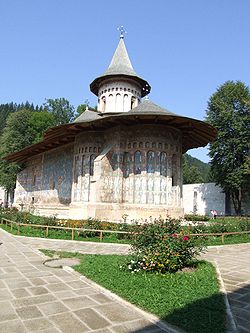- Voroneț Monastery
-
"Voroneţ" redirects here. For the village where the monastery is located, see Gura Humorului.
Voroneț Monastery 
Monastery information Full Name Voroneț Monastery Established 1488 Dedicated to Commemorate the victory at Battle of Vaslui. People Founder(s) Stephen III of Moldavia Site Location Voroneț, Suceava County, Romania Coordinates 47°31′1.56″N 25°51′51.3″E / 47.5171°N 25.86425°ECoordinates: 47°31′1.56″N 25°51′51.3″E / 47.5171°N 25.86425°E Visible Remains church Public Access yes Voroneț is a monastery in Romania, located in the town of Gura Humorului, Moldavia. It is one of the famous painted monasteries from southern Bukovina, in Suceava County. Between May and September 1488, Stephen III of Moldavia (known as "Stephen the Great", in Romanian Ștefan cel Mare) built the Voroneț Monastery (in Romanian Mănăstirea Voroneț) to commemorate the victory at Battle of Vaslui. Often known as the "Sistine Chapel of the East", the frescoes at Voroneț feature an intense shade of blue known in Romania as "Voroneț blue". "The exterior walls — including a representation of the Last Judgment on the west wall — were painted in 1547 with a background of vivid cerulean blue. This blue is so vibrant that art historians refer to Voroneț blue the same way they do Titian red."[1]
Contents
Church
The katholikon (main church) of Saint George at Voroneț Monastery is possibly the most famous church in Romania. It is known throughout the world for its exterior frescoes of bright and intense colours, and for the hundreds of well-preserved figures placed against the renowned azurite background. The age of the monastic site is not known. A legend tells us that Stephen the Great, in a moment of crisis during a war against the Ottoman Turks, came to Daniel the Hermit at his skete in Voroneț and asked for advice. After he won the battle against the Turks, keeping his promise to the monk, the Prince built a new church, dedicated to Saint George, the "bringer of victory in battle". The commemorative inscription placed above the original entrance of the Church of Saint George, now in the exonarthex, shows that the church was built in 1488 in less than four months. It was built on a triconch plan (with three apses), with a chancel, a naos with its tower, and a pronaos. In 1547, the Metropolitan Bishop of Moldavia, Grigorie Roșca, added the exonarthex to the west end of the church.
The small windows, their rectangular frames of crossed rods and the receding pointed or shouldered arches of the interior doorframes are Gothic. The south and north doors of the exonarthex of 1547 have rectangular frames, which indicate a transition period from Gothic to Renaissance. But, above them, on each wall is a tall window with a flamboyant Gothic arch. The whole west façade is without any openings, which indicates that the intention of the Metropolitan Roșca was from the beginning to reserve it for frescoes.
On the north façade is still visible the original decoration of the church, the rows of ceramic enamelled discs in yellow, brown and green, decorated in relief. These include heraldic motifs, such as the rampant lion and the aurochs' head of the Moldavian coat of arms, and creatures inspired by Western European mediaeval literature, such as two-tailed mermaids. The tower is decorated with sixteen tall niches, in four of which are windows. A row of small niches encircles the tower above them. The fragmented roof probably follows the shape of the original roof, which doubtless was made with shingles.
The tomb of the monastery's first abbot, Saint Daniil the Hermit, is found at the monastery.
The church is one of the Painted churches of northern Moldavia listed in UNESCO's list of World Heritage sites.
Gallery
-
The Last Judgment, painted on the exterior of the Church of St. George
-
Mural (top) Cain and Abel, (bottom) lives of saints
See also
Footnotes
- ^ Erik Sandberg-Diment, "Artistic Route Through Romania", The New York Times, June 21, 1998
References
-
- Sandberg-Diment, Erik. Artistic Route Through Romania, New York Times, The. 1998
External links
- 360° panoramic images from Voroneţ Monastery
- Romania's Painted Churches [1]
- Photos from Romania : Monastery Voroneț
- Photos of Mănăstirea Voroneț
- Voroneţ
- The Holy Monastery of Voroneţ Romania's National Institute for Research and Development in Informatics
- Bucovina - Treasures and Tranquillity
- The Voroneţ Monastery Rural Tourism in Romania
- Voroneţ Monastery
Categories:- World Heritage Sites in Romania
- Romanian Orthodox monasteries
- Bukovina
- Suceava County
- 1488 establishments
-
Wikimedia Foundation. 2010.




